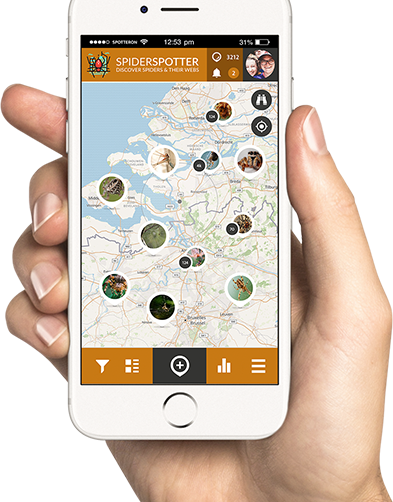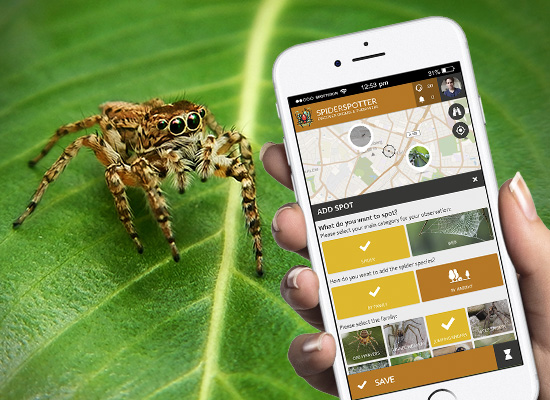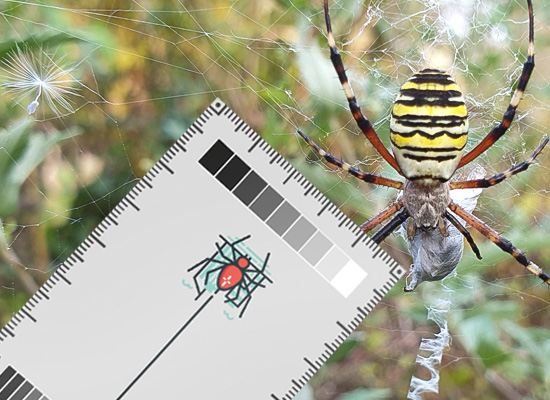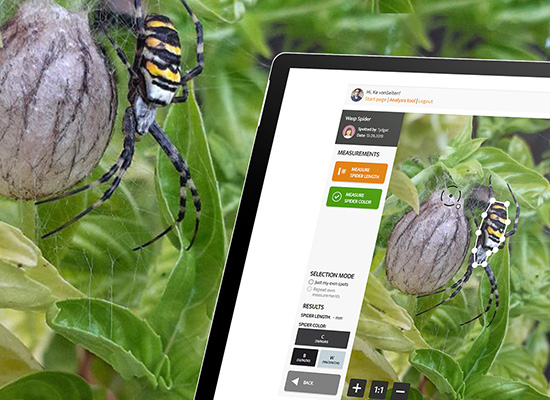
Download the SpiderSpotter App for Android or IOS and help with your observations!
Goldenrod spider (Misumena vatia)
Web: Crab spiders don’t make catching webs, but use their elongated first and second legs to overpower their prey. They are sit and wait predators, often well camouflaged and laying in an ambush to surprise passing prey.
Habitat: in sunny environments such as grassland, forest edges, but also gardens. Is very often found on flowers.
How to recognize?
Looks similar to:
Size
♀: 9-11 mm
♂: 3-4 mm
When?
♀: May till August
♂: May till August
Common crab spider (Xysticus cristatus)
Web: Crab spiders don’t make catching webs, but use their elongated first and second legs to overpower their prey. They are sit and wait predators, often well camouflaged and laying in an ambush to surprise passing prey.
Habitat: in many different environments such as grassland, on bushes and other low vegetation, rather in open habitats.
How to recognize:
Looks similar to:
Size
♀: 9-11 mm
♂: 3-4 mm
When?
♀: April till August
♂: April till August
Ozyptila praticola
Web: Crab spiders don’t make catching webs, but use their elongated first and second legs to overpower their prey. They are sit and wait predators, often well camouflaged and laying in an ambush to surprise passing prey.
Habitat: on the ground, in leaf litter or sometimes on low vegetation in gardens, parcs, forest,…
How to recognize:
Looks similar to:
Size
♀: 3-5 mm
♂: 2,5-3 mm
When?
♀: April till September
♂: April till September
Eurasian green crab spider (Diaea dorsata)
German name: Grüne Krabbenspinne
Web: Crab spiders don’t make catching webs, but use their elongated first and second legs to overpower their prey. They are sit and wait predators, often well camouflaged and laying in an ambush to surprise passing prey.
Habitat: on leaves of bushes and trees.
How to recognize:
Looks similar to:
Size
♀: 5-7 mm
♂: 3-4 mm
When?
♀: May till June
♂: May till June
Rabbit hutch spider (Steatoda bipunctata)
Web: 3D web with messy threads and often vertical threads with glue on the lower part towards the substrate (“gum footed threads”). The web sometimes has a matlike appearance.
Habitat: Mostly close to or in buildings, but also regularly outdoor in hollow trees, away from buildings. The spider often hides in a crevice.
Herkennen aan:
Looks similar to:
Size
♀: 4,5-7mm
♂: 4-5,5mm
When?
♀: throughout the year
♂: April till November
Triangulate combfoot (Steatoda triangulosa)
Web: 3D web with messy threads and often vertical threads with glue on the lower part towards the substrate (“gum footed threads”). The web sometimes has a matlike appearance.
Habitat: Mainly in dark places in buildings, contrary to the False black widow also in dry places such as attics. Or in living rooms on the underside of furniture, where you can often find egg sacs. Regularly also outdoors near solid structures. The spider usually hides in crevices.
How to recognize:
Looks similar to:
Size
♀: 3,5-7mm
♂: 3,5-5mm
When?
♀: throughout the year
♂: June till October
False black widow (Steatoda grossa)
Web: 3D web with messy threads and often vertical threads with glue on the lower part towards the substrate (“gum footed threads”).
Habitat: Mainly in dark places in buildings (preference for cellars, where webs are constructed close to the cellar window), but also outdoors near solid structures. The spider usually hides in crevices.
Hot to recognize:
Looks similar to:
Size
♀: 6,5-10mm
♂: 4-6mm
When?
♀: throughout the year
♂: August till September
Common stretch spider (Tetragnatha extensa)
Web: orb web with open centre (no threads).
Habitat: tall grasses (such as reeds) and low vegetation close to water. op hoge grassen (bijv. riet) en lage vegetatie in de buurt van water. More strongly bound to water than the Silver stretch spider.
How to recognize:
Looks similar to :
Size
♀: 10-12 mm
♂: 6-9 mm
When?
♀: May till July
♂: May till July
Silver stretch spider (Tetragnatha montana)
Web: orb web with open centre (no threads).
Habitat: occurs frequently on shaded banks, but also in bushes of gardens and parcs. Less bound to water compared to the Common stretch spider.
How to recognize:
Looks similar to:
Size
♀: 7-13 mm
♂: 6-8 mm
When?
♀: May till July
♂: May till July
Lesser garden spider (Metellina segmentata)
Web: small orb web that is suspended under an angle in grasses, herbs and low bushes.
Habitat: on vegetation in a lot of different habitats such as roadside, grassland, gardens, woodland. Often in large numbers.
How to recognize:
Looks similar to:
Size
♀: 6,5-9 mm
♂: 7-7,5 mm
When?
♀: August till October, but in mild winters, sometimes till early spring
♂: August till October

Download the App on your smartphone now or open the map in your browser:
Do you want to help measuring spiders for science? Download the SpiderSpotter Card for self printing at home and hold it in the pictures you take in the SpiderSpotter App. With the measurement reference, we can determine the size of your spider or web observation better. You can also order it at spiderspotter@UGent.be, provide your address and the number of cards you need and we will send them to you!
When holding the SpiderSpotter Card near the spider or a spider's web, please make sure that a ruler and one of the brigthness gradient strips is visible in the picture. You can read more about how to take the pics in our info section!


With the new SpiderSpotter Data Analysis Tool, you can actively participate in generating scientific data! The online interface fetches spider observations live from the Citizen Science App and offers a range of tools to measure the size and the average colour of the spiders. Simply access the Data Analysis Tool and log in with your App account!
You can even select an option to just work with your observations from the App and export your measured data if you want to do your own analysis.